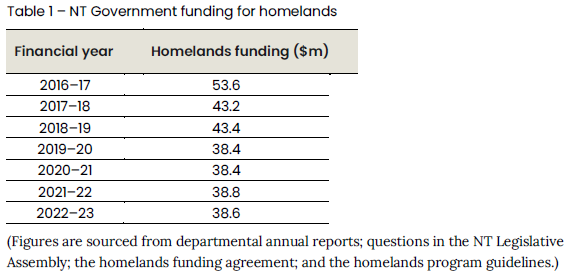GOVERNMENT SUBMISSION: AHNT’s submission to the Housing and Homelessness Plan
Aboriginal Housing Northern Territory (AHNT) is the community-driven peak body for Aboriginal housing in the NT, representing 16 housing and homeland service providers and 4 land councils across the NT – about 80,000 people.
Their submission from late 2023 to the National Housing and Homelessness Plan is an important one.

The submission by AHNT describes the reality of the situation of housing, homelessness, and homelands across the NT and calls urgently for improvements through 11 recommendations. They remind us that the solution is Aboriginal-led. Aboriginal authority, Aboriginal agency, and Aboriginal community control is missing from the system as a whole, and unless the system embodies and nurtures self-determination, it will continue to fail Aboriginal people.
Housing is a key determinant of health.
Homelessness Chapter Overview
In the NT, homelessness rates are 12 times more (per capita) than in the rest of Australia, almost all are Aboriginal.
Commonwealth funding for homelessness is allocated in accordance with the population. For the NT, a tiny portion of funding might be commensurate with its population but it will never be enough to adequately support the 13,000 homeless people, or to meet target 9a of the plan for Closing the Gap.
Many Aboriginal houses are severely crowded – this is a form of homelessness. The negative effects of crowding are well-documented including:
- Higher rates of infectious disease and parasites
- AIHW reports from 2017-2021, 371 Aboriginal people in the NT were diagnosed with acute rheumatic fever – accounting for 55% of ALL Australian cases of the disease.
Housing Chapter Overview
Around 80,000 Indigenous people live in the NT. Many Aboriginal people live in the town centres of Darwin, Katherine, Tennant Creek and Alice Springs – and 43 nearby town camps – but the population is highly distributed – there are 73 remote communities and around 500 homelands.
Housing options include ‘affordable’ housing, government (public) housing in one of 73 remote communities, and community housing, which is generally limited to the larger town centres and town camps, although some housing is available on Aboriginal homelands.
With housing in such short supply, houses are shared with extended family members who are homeless or visiting – which puts more pressure on the structures and facilities and increases their rate of deterioration. As a result, maintenance and repair works are needed sooner.
Recently, Menzies School of Health Research evaluated the NT Government’s ‘Healthy Homes’ program of remote housing repairs and maintenance. They report that where Healthabitat was contracted to run Housing for Health projects, house function significantly improved, but those projects only reach a small proportion of remote community houses.
Climate fitness – Climate change is hitting the most vulnerable people hardest. It is crucial to mitigate the risks associated with extreme heat, and to find ways to make Aboriginal housing safer and more comfortable.
Cultural fitness – Aboriginal housing should enable Aboriginal people to live in accordance with their cultural imperatives and protocols. If it doesn’t, it will be uncomfortable and might remain unused. Across the NT, there are dozens of language groups, each with their own cultural specificity, so a single design won’t be a good fit for all Aboriginal people. The best way to ensure cultural fitness of Aboriginal housing is to involve prospective residents in the design and build of their houses.
Homelands Chapter Overview
Homelands and outstations are interchangeable terms used in different parts of the NT to describe remote areas where small populations of Aboriginal people live, on lands where they have traditional ownership or historical association.
Most homelands are located on Aboriginal land held by Aboriginal land trusts established under the Aboriginal Land Rights (Northern Territory) Act 1976 (ALRA). A small number have other statutory tenures, such as community living areas (CLAs) – land excised from a pastoral lease – or parcels of land within national parks. As such, the process to formally establish a new homeland with infrastructure usually involves the relevant land council. Generally, housing in homelands is communally owned under the ALRA, not subject to NT Government leasing nor part of the NT’s remote public housing system and so exists in a policy vacuum. There is a lack of clarity on who is responsible for the assets, rents, and maintenance.
In seven years, the NT Government has steadily reduced its funding for homelands repairs and maintenance, municipal and essential services and capital improvements by 28% – from $53.6 million to $38.6 million.
Recommendations
- Provide fair and reasonable funding for homelessness services in the NT – in accordance with the actual need.
- Dramatically expand Housing for Health projects and the Healthabitat approach to monitoring, on-the-spot repairs and preventive maintenance.
- Allocate 20% of all HAFF spending to Aboriginal housing, in perpetuity.
- In conjunction with the NT Government, AHNT and land councils, sign up to a long-term agreement for remote housing – including on homelands.
- In conjunction with the NT Government, partner with the First Nations Clean Energy Network to expand access to renewable energy in Aboriginal housing throughout the NT.
- Recognise that climate change is deepening the Aboriginal housing crisis, declare it an emergency, and establish tripartite channels to work with Aboriginal communities to devise and deploy mitigations and solutions at every scale.
- When designing and constructing any Aboriginal housing, be led by Aboriginal people.
- Explore and clarify homelands tenure arrangements to support self-determination for Aboriginal landowners and enable external financial investment.
- Commit to investing a minimum of $100 million on NT homelands housing and infrastructure repairs and upgrades each year for the next 15 years.
- In conjunction with the NT Government, activate your commitments to priority reforms under Closing the Gap so that those commitments infiltrate every public policy and practice.
- Support AHNT and NT land councils at every stage of the effort to establish Aboriginal community-controlled governance for Aboriginal housing in the NT.
Interestingly the current work of Healthabitat in this submission is recommendation #2 and urges for the work to continue from the proof the work significantly improves house function and hence health and safety of these houses. This is in line with the Menzies evaluation from September 2023 of the NTG ‘Healthy Homes’ program where Healthabitat’s work featured as the first 5/32 recommendations. Furthermore, recommendation #9 is an important one, asking for the commitment of regular and set $’s for a significant timeframe to allow for maintenance, repairs and upgrades to be planned and to occur.
Like the content in many other submissions made, we support the work and advocacy by AHNT, and hope they are strongly considered in the new National Housing and Homelessness Plan.










